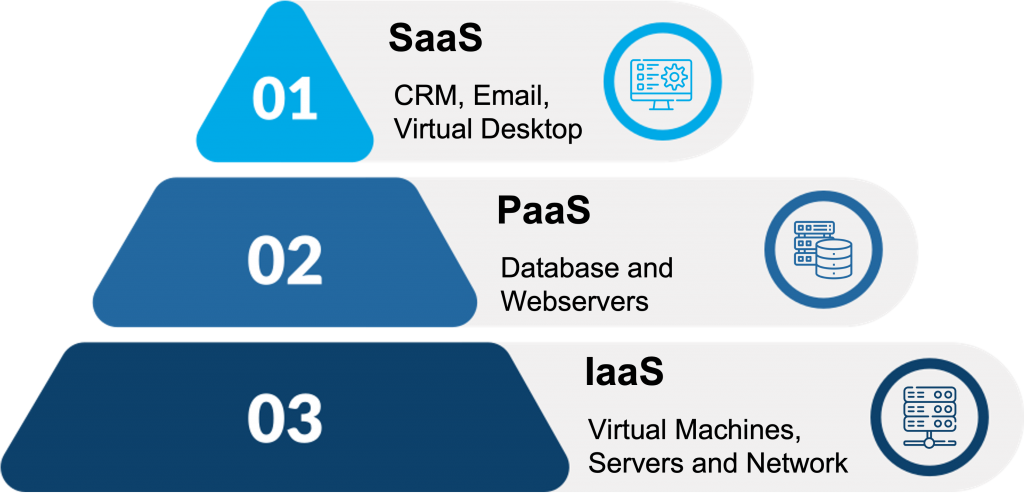In the digital world, enterprises need to move faster with technology. With the advent of cloud computing, enterprises can now revolutionize their business operations more efficiently and in a quicker manner while reducing costs. But, enterprises are often confused about migrating to the cloud as they are more concerned about security issues, data loss, privacy risks, and others. In this article, let us explore the key cloud computing technologies in the market and their advantages.
Introduction to Cloud Computing
Cloud computing can be simply defined as a means of storing and accessing data through the internet. It is a technology that uses virtualization to provide enterprises with on-demand data storage, virtual servers, disaster recovery, and other cloud services that are built on a framework similar to remote infrastructure.
Cloud computing has a pyramid-like structure with three different layers. The different layers of cloud services are, Software as a Service (SaaSAzure), Platform as a Service (PaaS), and Infrastructure as a Service (IaaS). The bottom layers have higher capabilities such as virtual machines and data centers while the top layers have applications and frameworks. The bottom layers represent more customized features for various applications while the top layers are purposely built for specific tasks.

Why Cloud Computing can be a Game Changer for Enterprises?
Enterprises that are using an on-premise environment require more capital expenses for the operational and maintenance costs while cloud-based use virtual technology to host the applications. Cloud computing differs from on-premises in many ways. It provides more advanced and efficient ways for enterprises to connect with their customers and partners from anywhere with minimal maintenance.
Many enterprises have adapted their business models to cloud computing. There is a myth that the cloud is mainly beneficial for data backups and virtual servers. Still, the fact is that cloud computing has many benefits that can help enterprises improve their overall efficiency. Below are the benefits of cloud computing are as follows,
- Simple Infrastructure
- Cost-Efficient
- Storage Space
- Highly Scalable
- Data Backups and Recovery
- Flexible in Nature
- Disaster Recovery
Simple Infrastructure
Cloud infrastructures are virtual services that are easy to set up and install. They do not require any in-house server hardware, software licenses, or integrations. Enterprises can scale up or down as per their computing requirements and can pay for the services only for what they used.
Cost-Efficient
Implementation of the cloud can be helpful for enterprises in terms of cost savings while purchasing, maintaining, and upgrading the systems. With this, the cloud model converts the existing capital expenditure to operational expenditure. Cloud also provides some advanced features such as one-time payment, ‘pay as you go’ model, and other customized packages through which enterprises significantly lower their IT costs.
Storage Space
With the cloud, enterprises will not require any type of software programs or data backup which consumes a lot of space as all the data is being stored in remote servers within the cloud. This not only provides free in-house space but also provides unlimited space within the cloud.
Highly Scalable
Cloud can help enterprises expand their resources, whether it be startups or well established firms. It can easily optimize the resources and minimize the overall operational costs.
Data Backups and Recovery
Cloud storage is the major benefit of cloud computing, as any data can be stored in the cloud and can be accessed easily. Also, with cloud storage, data can be easily accessible from anywhere in the world and from any device which makes it ideal for enterprises.
Flexible in Nature
Enterprises have started to understand the importance of cloud computing for today’s digital work environment. According to a recent survey, cloud computing offers greater flexibility to employees. Using cloud computing, data can be accessed from any device on the internet around the world.
Disaster Recovery
Enterprises around the world are looking to invest in durable disaster recovery systems, irrespective of the size they are. Some smaller enterprises which do not have allocated budget and skills for this will have to search for more options in order to save themselves. Here, cloud computing comes into the picture, as it can save time while reducing upfront investments and also involves third-party expertise to deploy cloud-based backup and restore solutions.
Comparison between the Leading Cloud Providers (in terms of market share)

Cloud has been a revolution in the IT space and it has changed the digital world with its significant features. AWS and Microsoft are the topmost cloud service providers with the best services. The implementation of the cloud not only benefits the enterprises but also employees who are working on the cloud play a major role in providing innovative solutions and helping the customers in providing the specific cloud as per the requirement. Enterprises can help customers of all sizes to design, architect, build, migrate, and manage their workloads and applications on the cloud.




